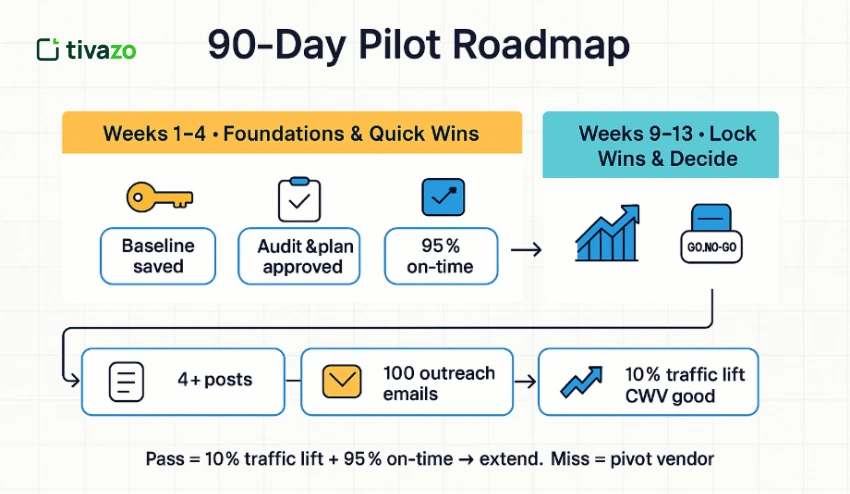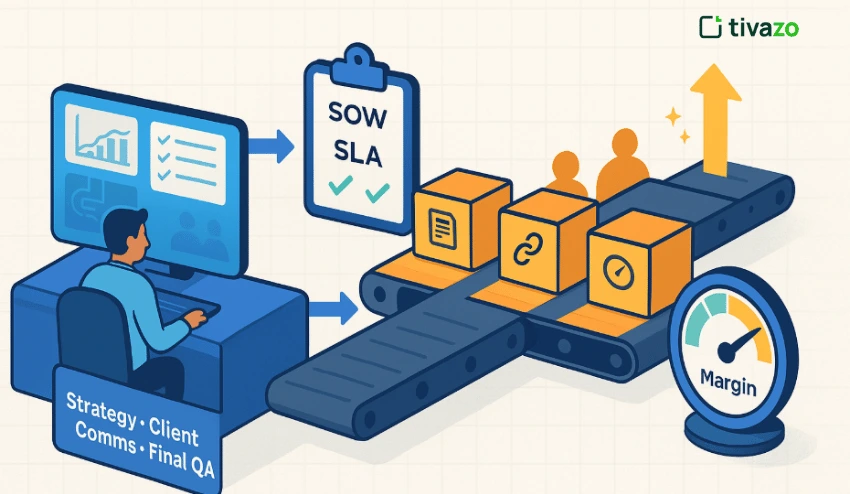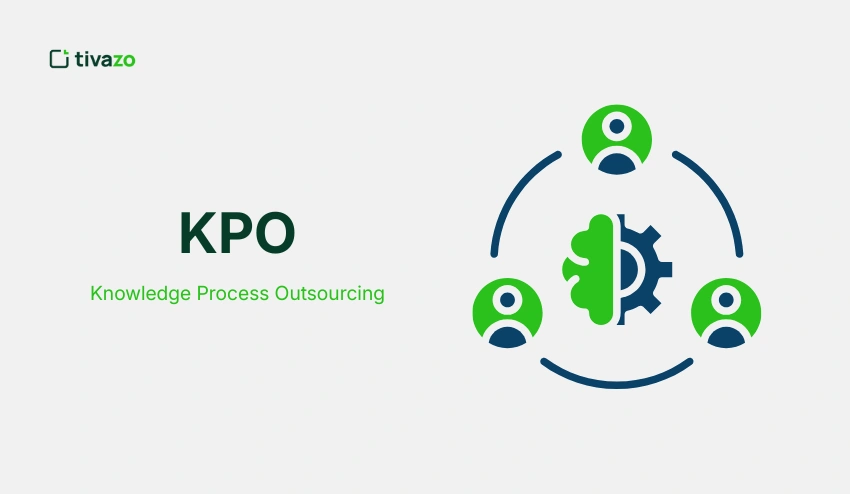The fix? Outsource production while you keep the strategy. Done right, you’ll lift capacity without lifting payroll; done wrong, you’ll trade margin pain for quality chaos.
This playbook gives you the safe path: a readiness checklist, model comparison, iron-clad SOW & SLA templates, and a 90-day pilot that proves ROI before you commit.
Quick diagnostic: Are you truly ready to outsource?
Seo Outsourcing helps only when it plugs a visible gap, not a hazy sense of “busy.” Tick off each warning sign:
- Your production calendar wobbles like Jenga; one new client topples the stack.
- Specialist tasks (technical audits, link outreach) fall to generalists who binge YouTube tutorials.
- Gross margin slips below 50 percent after salaries, tools, and revision rounds.
- Projects get bumped to next quarter because the team has zero bandwidth.
- Clients ask for blended packages (content, links, CRO), and you find yourself pricing freelancers.
- Deliverables arrive late, sparking “quick update” emails that chip away at trust.
- Revenue climbs, yet payroll outruns it and drains profit.
Score yourself:
0–2 “yes” answers: tighten processes or hire a specialist.
3 or more: seo outsourcing is your quickest path back to healthy margins and calm work-weeks.
Keep your score handy. The next section matches each risk profile to the right delivery model and shows where an SEO reseller fits. For a vetted option, see this white label SEO reseller program by Agency Platform, trusted by 1,000+ agencies with packages from $178/month.
Choosing an seo outsourcing model
The core options on the table
You have three practical ways to deliver SEO work without swelling payroll:
- In-house team. A full-time SEO specialist in the United States earns about $65,000 per year (roughly $5,400 per month) before benefits. Control is highest, but those fixed salaries drain cash during slow sales months.
- Freelancers. Tap specialists for bite-sized tasks, such as ten hours for a schema fix or three writers for blog production. You’ll pay only for what you use, yet you become the project manager to manage the project and the QA gate for contractors spread across time zones.
- White-label SEO reseller program. Purchase a wholesale package of content, links, and audits from a vetted team that works under your brand. Agencies often resell these services at 100–200 percent margin targets, especially after crossing the ten-retainer mark, because fixed overhead stays low while volume rises.
No single model fits every scenario. Many agencies run a hybrid approach, keeping strategy in-house, leaning on freelancers for overflow, and adding a reseller partner when client volume spikes. The next section breaks down dollars, hours, and hidden trade-offs so you can pick the right mix for your growth plan.
Defining scope and quality: the living SOW and SLA
SEO Outsourcing without guardrails is risky. A tight statement of work (SOW) and service level agreement (SLA) keep both agency and vendor on track and protect your margin.
Scope first
Treat the SOW like a build sheet. Spell out every deliverable in plain English:
Rewrite H1s, meta titles, and meta descriptions for /services, /pricing, and eight sub-pages is explicit; optimize ten service pages is not.
Add quality metrics
- Content — at least 1,000 words, zero percent plagiarism, brand voice checklist
- Links — DA thirty and higher, topical relevance, no PBNs
- Technical — all Core Web Vitals in the “good” range
Time standards belong in the SLA
Minor revisions within 1–2 business days, moderate in 3–5, major in 5–7. Require the vendor to answer questions within 24 hours and hit 95 percent on-time delivery or better.
Communication cadence
Weekly Slack sync, shared Kanban board, and a white-label monthly report. Transparency runs both ways: you watch progress; they give prompt feedback.
Revisions and replacements
Cap free edits at two rounds per asset and insist on no-cost link replacement if a backlink drops within 90 days (according to Content Vista).
Update these documents whenever Google’s rules change or your offer evolves. A living SOW plus SLA means clear scope, measurable quality, and deadlines everyone respects.
Roles, responsibilities, and the RACI safety net
A RACI matrix keeps seo outsourcing tidy by showing who is Responsible, who is Accountable, who is Consulted, and who is Informed for every task.
| Task | Vendor SEO lead | Agency strategist | Account manager | Client |
| Keyword map | R | A | C | I |
| On-page fixes | R | A | C | I |
| Content draft QA | R | C | I | – |
| Monthly report | R | A | R | I |
Build it before kickoff. List recurring tasks down the left, roles across the top, and assign letters in a fifteen-minute meeting.
Review it whenever the scope shifts. New CRO initiative? Add a row, assign letters, and share the update.
The payoff: no “I thought you had it” emails, your strategist skips line edits, and the client always views your agency as accountable for results, not the vendor.
Quality assurance: inspect what you expect
A lightweight, weekly QA loop keeps outsourced work pristine, long before clients see it.
Monday 30-minute check. One team member reviews new deliverables:
- Run a plagiarism scan and flag anything over three percent similarity.
- Confirm tone and keyword placement in headers and snippets.
Link spot-check (five minutes). Pull a random sample in Ahrefs; look for live pages with traffic, diverse anchors, and less than ten percent exact-match. Google’s June 2024 Link Spam update penalised over-optimised anchors and low-quality guest posts.
Technical “trust-then-verify.” Push fixes to staging, crawl the site, and deploy to production only when Core Web Vitals stay green.
Document each pass in a shared sheet and return feedback within the same business day. Vendors learn to expect scrutiny, and you catch issues while they’re still easy and inexpensive to fix.
Productized services: packaging SEO for profit
Why productize before you price
Billing by the hour feels transparent, but when scope drifts, profit melts. Packaging flips the script: you bundle outcomes, lock production cost, and price for value instead of time.
Example: “Local booster” package
| Deliverable | Quantity per month | Vendor cost |
| Citation cleanup | 30 listings | $200 |
| GBP optimisation | 1 profile | $100 |
| Geo-focused blog posts | 2 articles | $240 |
| Niche-relevant backlinks | 5 links | $160 |
| Total wholesale | $700 |
Sell the bundle for $2,000, and you keep a 65 percent gross margin. Agencies often mark up white-label SEO by 100–200 percent— a range many white-label resellers use to hit about 60 percent gross margin, according to Vendasta.
Productizing calms clients because named packages set expectations and curb “one-more-tweak” requests. A new account drops into the same SOP, your vendor handles the lift, and margin stays predictable.
Next, we’ll sketch three package tiers and run the quick math that keeps profit solid
The 90-day pilot: prove ROI before you go all in

Agencies that set a structured onboarding plan for the first 90 days cut early client churn by more than half, according to Seven Figure Agency. Use the timeline below to test a new vendor under real deadlines, then keep or drop the partnership based on data.
| Week | Milestone | Owner | KPI to watch |
| 1 | Kick-off call, grant GA4/Search Console/CMS access, save baseline metrics (traffic, rankings, links) | AM + vendor lead | Baseline captured |
| 2 | Vendor delivers technical audit and three-month content/link plan; agency approves within 48 hours | Vendor R, Strategist A | Audit completed |
| 3–4 | Publish two blog posts, fix priority meta tags, start outreach; 30-minute alignment call end of Week 4 | Shared | 100 percent tasks on time |
| 5–8 | Raise cadence to one post per week, expand link targets; mid-month KPI pulse check | Vendor R, Strategist C | Early ranking lift |
| 9–11 | Final content and links, polish tech loose ends; compile before/after metrics | Vendor R, AM A | At least ten percent organic traffic lift |
| 13 | Decision meeting; renew, tweak, or exit via trial clause | Agency leadership | ROI vs. target |
Success threshold example: ten percent traffic gain and 95 percent on-time delivery. Miss the mark? Pivot vendors before sunk costs pile up. Hit it? Lock a longer scope at volume pricing and roll the same playbook to the next account
Month 1: foundations and quick wins
| Week | Key actions | KPI |
| 1 | Kick-off call; open Slack channel; grant GA4, Search Console, and CMS access; save baseline traffic, ranking, and backlink numbers | Baseline captured |
| 2 | Vendor delivers technical audits within five days for sites under 1,000 pages (AIOSEO technical audit guide) plus a three-month content and link plan. Agency signs off inside 48 hours. | Audit and plan approved |
| 3 | Implement quick-win fixes: compress images, redirect orphan URLs, add missing meta titles. | 100 percent tasks completed |
| 4 | Publish two blog posts and update priority pages; launch link outreach. End-of-week 30-minute alignment call confirms everything shipped on time. | On-time delivery at least 95 percent |
Month 2: scale with control
| Week | Key actions | KPI target |
| 5–6 | Raise cadence to one blog post per week and ten outreach emails per day. Launch a second wave of on-page updates. | Output at least four posts and 100 outreach emails |
| 6 | Mid-month pulse: track priority-keyword positions and organic sessions. | Three percent ranking improvement vs. baseline |
| 7–8 | Continue content and links; resolve any bottlenecks flagged in pulse check (for example, shift anchor text mix or add internal links). | All corrective actions closed within three days |
| 8 | Client touch-point: Slack summary Monday, Asana screenshot Friday, 30-minute client call with branded report. | Report delivered on schedule |
Month 3: lock in wins and decide
| Week | Key actions | Success KPI |
| 9–10 | Publish final content pieces; fulfil remaining link quotas | Content calendar 100 percent complete |
| 11 | All Core Web Vitals are “good” | Ten percent traffic gain |
| 12 | Polish technical loose ends; prepare ROI deck | All Core Web Vitals “good” |
| 13 | Decision meeting: renew, tweak, or exit via trial clause | Go/No-Go signed |
If the vendor meets or beats the KPI and hits 95 percent on-time delivery, extend the scope at volume pricing. Miss the marks? Pivot fast before sunk costs pile up. This binary close keeps the pilot objective and your margin intact.
White-label reporting and client communication
Clients pay for clarity as much as rankings, so your report must be spotless.
- Live dashboard. Set up a branded Looker Studio view or use a white-label SEO dashboard like Agency Platform to offer branded reporting and client logins. Agencies that automate dashboards save about two hours per client each week, according to Metrics Watch. Show at the top:
- Organic sessions
- Goal conversions
- Average position for priority keywords
- “What we did” digest. One short paragraph, no jargon: Optimised seven product pages, published two authority blogs, secured six new links from sites with more than one thousand monthly visits.
- Insight + next step. Tie data to strategy: Non-brand clicks spiked after last month’s guides; we’ll clone that format for the accessories category. By next update, we’ll addthe FAQ schema and pitch three podcast backlinks.
- Walk-through call. Deliver the deck in a scheduled monthly meeting, not as an attachment. Explaining results in real time keeps relationships sticky and positions you as the strategic voice while the vendor stays invisible.
Vendor performance scorecard: pick winners, spot slackers
Convert gut feelings into numbers with a simple weighted scorecard.
| Criterion | Weight | 1 (poor) | 3 (good) | 5 (excellent) |
| Expertise & work quality | 30 percent | Few or no case studies | Meets guidelines | Proven success stories, flawless test project |
| Communication speed | 20 percent | more than 48 hours to reply | less than 24 hours | same-day reply plus proactive updates |
| Reliability (deadlines) | 15 percent | under 70 percent on-time | 70–90 percent | over 90 percent on-time |
| Transparency & reporting | 10 percent | Vague or no logs | Monthly reports | Real-time dashboards and open task board |
| Cost effectiveness | 10 percent | Cheap but heavy rework | Fair for value | Wholesale rates, minimal rework |
| Scalability | 10 percent | Cannot add capacity | plus three projects | plus ten projects in 30 days |
| Cultural fit | 5 percent | Friction | Neutral | Collaborative, solutions-oriented |
Multiply each rating by the weight, then add the results to reach 100. Industry practitioners keep vendors scoring eighty or higher, place those at seventy to seventy-nine on an improvement plan, and replace any below seventy. Seven Figure Agency suggests re-evaluating partners that drop under seventy-five during quarterly reviews.
Re-score vendors every quarter. Numbers climb when partners refine processes, and they slide when turnover erodes quality. Data, not drama, decides who stays on your bench.
Risk management and red flags
Think of risk control as a three-step loop: anticipate → monitor → respond.
- Start small. Limit the first project to one mid-tier client (under a three-thousand-dollar monthly retainer). This step protects revenue if the vendor slips.
- Keep leverage. Pay monthly or at delivery milestones; never pre-fund more than 30 percent of the contract.
- Watch early signals.
- Plagiarism above three percent in Copyscape
- Replies more than 24 hours late
- Vague link sources or missing outreach logs
If any two signals appear, pause and review.
- Firewall the client. Vendors get no direct email or social access; store all credentials in a password vault with role-based permissions.
- Maintain a Plan B. Keep at least two backup writers and one link vendor on standby so you can pivot inside 72 hours.
- Track Google changes. Major algorithm updates hit four to six times per year, according to Search Engine Land. After each, tighten QA on links and content and update SLAs if tactics need revision.
Risk never drops to zero, but these guardrails keep it inside your profit target.
Conclusion
SEO Outsourcing SEO isn’t about replacing your team—it’s about scaling smarter. By keeping strategy, client communication, and final QA in-house while handing off execution to vetted partners, agencies can expand capacity, protect margins, and deliver consistent results without ballooning payroll. The key is structure: clear SOWs and SLAs, productized packages, disciplined QA, and a 90-day pilot that proves ROI before you commit. Done right, seo outsourcing transforms from a risky shortcut into a repeatable growth engine that lets your agency scale margin, not headcount.




